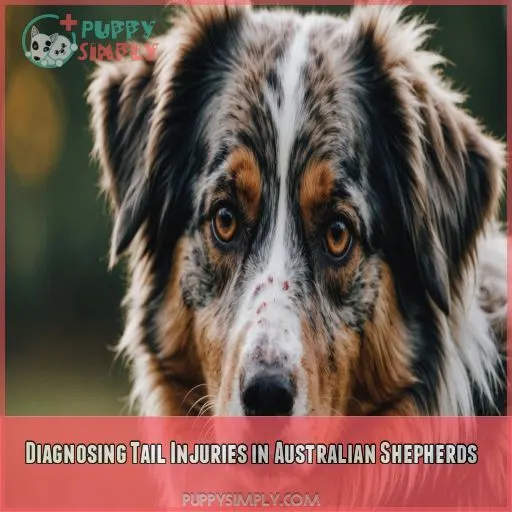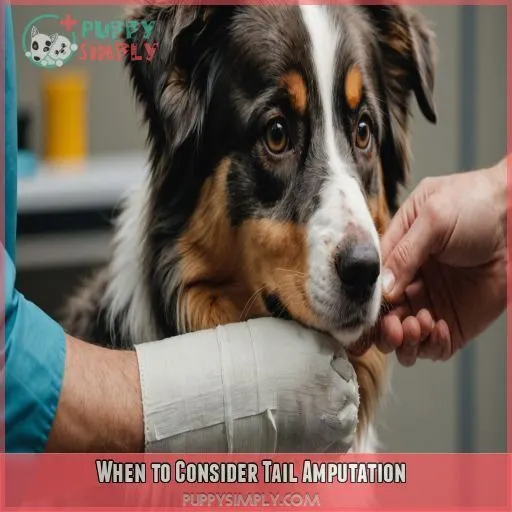This site is supported by our readers. We may earn a commission, at no cost to you, if you purchase through links.

As an Australian Shepherd owner, it’s important to understand when tail amputation might be needed due to serious injuries, chronic wounds that won’t heal, or ongoing pain.
Thanks to advances in veterinary care, tail amputation can be a successful and relatively safe procedure when done with a clear understanding of the tail’s anatomy and function.
By exploring common injuries, diagnosis, and treatment options, you’ll be better equipped to make informed decisions about your furry friend’s care.
And, as you learn more about tail amputation and its implications, you’ll be well on your way to becoming a savvy, compassionate companion.
Table Of Contents
- Key Takeaways
- Australian Shepherd Tail Anatomy and Function
- Common Tail Injuries in Australian Shepherds
- Diagnosing Tail Injuries in Australian Shepherds
- Conservative Treatment Options for Tail Injuries
- When to Consider Tail Amputation
- Tail Amputation Procedure in Australian Shepherds
- Recovery and Adaptation After Tail Amputation
- Frequently Asked Questions (FAQs)
- When to amputate a dog’s tail?
- Why do they cut the tails off of Australian shepherds?
- What happens if a dog’s tail is injured?
- What is an avulsion injury in a dog’s tail?
- What is the average cost of tail injury treatment in Australian Shepherds?
- Is tail docking still a common practice in Australian Shepherd breeders?
- Can tail injuries in Australian Shepherds be prevented through training and exercise?
- How do veterinarians determine if an Australian Shepherd requires tail amputation?
- Can a docked tail affect an Australian Shepherds working ability and overall performance?
- Conclusion
Key Takeaways
- You’re not alone in dealing with your Aussie’s tail injuries – from Happy Tail Syndrome to severe trauma, it’s essential to recognize the signs and symptoms to provide your furry friend with the best possible care.
- Understanding your Australian Shepherd‘s tail anatomy and how it works can help you spot potential issues and keep your furry friend healthy and happy – and you’ll be better equipped to make informed decisions if your Aussie suffers an injury that may require tail amputation.
- When your Australian Shepherd’s tail injury is severe, non-healing, or impacting their quality of life, tail amputation might be the kindest option – your vet will consider pain management, alternative treatments, and post-op care to ensure your dog’s comfort and well-being.
- After tail amputation, your Australian Shepherd will need time to adjust to their new body, and with patience, love, and careful watchfulness, your dog will adapt and learn to thrive without their tail – focus on wound healing, behavioral changes, and long-term effects on balance and communication to support their recovery.
Australian Shepherd Tail Anatomy and Function
You might think your Aussie’s tail is just for wagging, but it’s a complex structure with important functions. Understanding your Australian Shepherd’s tail anatomy and how it works can help you spot potential issues and keep your furry friend healthy and happy.
Tail Structure and Vertebrae
Your Australian Shepherd’s tail is made up of 19-23 vertebrae, which give it flexibility and movement.
The caudal muscles control its wagging motion, while nerve innervation helps with sensation.
The blood supply is essential for keeping the tail healthy.
Understanding the tail’s anatomy can help you make informed decisions if your Aussie suffers an injury that may require tail amputation.
Role in Balance and Communication
Your Australian Shepherd’s tail plays a crucial role in their balance and communication.
Their tail acts like a counterbalance, helping them make sharp turns while herding or playing.
It’s also an essential tool for canine expression, conveying emotions like excitement, fear, or happiness.
Breed-Specific Tail Characteristics
Now that you know how important tails are for balance and communication, let’s talk about what makes the Australian Shepherd’s tail unique.
This breed’s tail is typically medium-length, feathered, and carried low when relaxed.
According to breed standards, a docked tail isn’t required, but some owners prefer it for appearance. Ironically, natural tails are now widely accepted and even preferred in many breed clubs.
Giving your Aussie a lovely, authentic look.
Common Tail Injuries in Australian Shepherds
As an Australian Shepherd owner, you’re likely no stranger to the importance of your dog’s tail in their daily life.
You may not be aware of the common tail injuries that can affect them, such as Happy Tail Syndrome, trauma-induced injuries, avulsion injuries, and degenerative tail conditions.
These injuries can be painful and potentially lead to long-term damage or even require tail amputation.
This is why it’s essential to recognize the signs and symptoms to provide your furry friend with the best possible care.
Happy Tail Syndrome
You know the joy of seeing your Australian Shepherd’s wagging tail? But what if that enthusiasm leads to Happy Tail Syndrome? This painful condition occurs when their tail hits objects repeatedly, causing injury. Prevention is key: consider tail wrapping methods or adjust their environment to reduce tail wagging intensity.
Trauma-Induced Injuries
If your Australian Shepherd experiences a traumatic injury, like being hit by a car or caught in a door, it can be devastating. Tail trauma can cause severe pain, bleeding, and swelling. Prompt veterinary care is essential for proper wound cleaning, hemostasis, and tension-free closure to promote healing.
Avulsion Injuries
You’re dealing with an avulsion injury, where your Australian Shepherd’s tail skin and soft tissue are pulled away from the bone. This painful injury can lead to bleeding, infection, and avulsion fractures. Prompt veterinary care, pain management, and rehabilitation techniques are essential to prevent complications and promote healing.
Degenerative Tail Conditions
Let’s talk about degenerative tail conditions that can affect your Australian Shepherd. These can be painful and impact their quality of life. Some common conditions include:
- Tail arthritis and bone spurs that cause chronic pain
- Tail nerve damage, leading to numbness or tingling
- Chronic tail sprains that just won’t heal
Diagnosing Tail Injuries in Australian Shepherds
If your Australian Shepherd has suffered a tail injury, you’re probably worried and unsure about the best course of action.
To determine the extent of the damage and decide on the most effective treatment plan, your veterinarian will perform a thorough physical examination. This examination may be accompanied by imaging tests, a neurological assessment, and an evaluation of your dog’s pain and mobility.
An accurate diagnosis is the first step in determining the best course of action. Your veterinarian will use a combination of physical examination, imaging methods, neurological assessment, and pain and mobility evaluation to diagnose the extent of the injury.
This diagnosis will help decide if tail amputation is unavoidable, ultimately leading in the direction of the best treatment.
Physical Examination Techniques
Let’s get hands-on! To diagnose tail injuries in your Australian Shepherd, your vet will use physical examination techniques like palpation, visual inspection, range testing, sensitivity assessment, and reflex evaluation. These methods help identify pain, swelling, or numbness, guiding the next steps in your dog’s care and tail injury management.
Imaging Methods (X-rays, MRI, CT)
You’re trying to figure out what’s going on with your Australian Shepherd’s injured tail. Imaging methods like X-rays, MRI, and CT scans can help. These radiology techniques provide a clear picture of the damage, but remember to prioritize X-ray safety and consider MRI limitations. Cosmetic concerns take a backseat here.
Neurological Assessment
When evaluating your Australian Shepherd’s tail injury, a neurological evaluation is vital. Your vet will use pain response tests, sensory evaluation methods, and motor function analysis to check for nerve damage. Reflex testing techniques and cognitive function checks will also help determine the best course of action for your furry friend.
Pain and Mobility Evaluation
Now that we’ve covered neurological assessment, let’s talk pain and mobility evaluation. Your vet will perform a gait analysis to assess your Australian Shepherd’s movement and pain scoring to gauge their discomfort level. They may also recommend mobility aids, canine rehabilitation, or sensitivity threshold testing to develop a treatment plan.
Conservative Treatment Options for Tail Injuries
If your Australian Shepherd has suffered a tail injury, you’re probably worried about what comes next and want to explore all your options before surgery. Fortunately, many tail injuries can be managed with conservative treatment options, which may include a combination of rest, bandaging, pain management, and physical therapy to help your furry friend heal and regain their signature swagger.
Rest and Activity Restriction
Now that you’ve diagnosed your Australian Shepherd’s tail injury, it’s time to give them a break – literally! Rest and activity restriction are key for healing. Limit exercise to short, gentle walks and avoid strenuous activities for 7-10 days. Monitor their progress and adjust their routine as needed.
Bandaging and Protective Devices
Now that your Australian Shepherd is getting some rest, it’s time to think about protecting that injured tail. You’ll want to stabilize the injury and prevent further damage. Here are some options:
- Tail wraps or bandages to immobilize the tail
- Support slings to take pressure off the injury
- Protective cones or sleeves to prevent accidental knocks or bumps
Pain Management Strategies
Now that you’ve bandaged your Australian Shepherd’s injured tail, it’s time to tackle pain management. Your vet will guide you on pain medication options, and you can also explore alternative therapies like acupuncture or laser therapy. As the owner, it’s your responsibility to monitor your dog’s comfort and adjust their care plan accordingly.
Physical Therapy and Rehabilitation
Now that you’ve got a solid pain management plan, it’s time to get moving with physical therapy and rehabilitation. This is essential in helping your Aussie regain strength, mobility, and confidence after a tail injury. Here are some exercises to get you started:
- Canine exercise routines, such as short walks and gentle stretches
- Massage therapy to promote healing and relaxation
- Balance and proprioception exercises to help your Aussie adjust to their new tail (or lack thereof)
When to Consider Tail Amputation
You’re facing a tough decision about your Australian Shepherd’s injured tail, and you’re wondering if amputation is the best option. Let’s explore the situations where tail amputation might be unavoidable, including severe trauma cases, chronic non-healing injuries, and quality of life considerations that may lead your veterinarian to recommend this course of action.
Severe Trauma Cases
If your Australian Shepherd experiences severe trauma, such as a car accident or brutal attack, tail amputation might be necessary. Respond promptly with emergency veterinary care (Source) to prevent further complications. Accident prevention tips, like supervising off-leash play, can also minimize risk. Your vet will guide you through the tough decisions (Source).
Chronic Non-Healing Injuries
Chronic non-healing injuries can be a tail amputation game-changer. You’re likely exhausted from wound care challenges, pain management strategies, and dodging infection risk factors. If your Aussie’s tail is more hurt than help, it’s time to weigh amputation decision criteria. Set rehabilitation goals and consider what’s best for their future.
Quality of Life Considerations
You’re weighing the tough decision of tail amputation for your Australian Shepherd. Consider how it’ll impact their quality of life. Think about pain management, emotional well-being, and behavioral adaptations. Will they still enjoy social interactions and playtime? Mobility adjustments can be made, but prioritize their comfort and happiness .
Veterinary Recommendations
Your vet will recommend tail amputation if your Australian Shepherd’s injury is severe, non-healing, or impacting their quality of life. They’ll consider pain management, alternative treatments, and post-op care. Trust their expertise and discuss concerns openly. Together, you’ll make an informed decision that prioritizes your dog’s well-being and comfort.
Tail Amputation Procedure in Australian Shepherds
When you’re facing the tough decision of tail amputation for your Australian Shepherd, it’s important to understand the process so you can feel confident about your dog’s comfort and recovery.
This section will walk you through the tail amputation process, covering pre-operative preparation, anesthesia and pain control, surgical techniques, and post-operative care.
This way, you’ll know what to expect every step of the way.
Pre-operative Preparation
It’s time to prep your Aussie for surgery. A thorough pre-operative health assessment will identify potential risks. Your vet will discuss anesthesia risks, and educate you on post-op care. The surgical site will be cleaned and prepped. A solid plan will help your furry friend have a smooth recovery.
Anesthesia and Pain Control
Okay, so you’ve made the tough call about your Aussie’s tail and now you’re thinking about anesthesia and pain management. It’s a big deal to make sure your pup is comfortable and safe during the surgery. Here’s the lowdown –
- Anesthesia risks: Talk to your vet about potential risks like allergic reactions or breathing problems.
- Pain management options: Explore different options like local anesthesia, epidurals, or pain meds after the surgery.
- Dosage considerations: Your vet will figure out the right amount for your dog based on their size, age, and health.
- Recovery monitoring: Plan to watch your dog closely after surgery to make sure they’re comfortable and minimize pain.
Surgical Techniques
Now that your Australian Shepherd is under anesthesia, the surgical team will carefully disinfect the area and prepare the necessary instruments. The veterinarian will then make a precise incision, carefully dissect the tissue, and remove the damaged portion of the tail, taking care to minimize bleeding and promote smooth wound closure.
Post-operative Care
After surgery, your Australian Shepherd’s recovery is super important. Focus on pain management, wound healing, and activity restrictions to prevent complications. At home, provide a quiet space, monitor the wound, and follow your vet’s instructions. Schedule follow-up appointments to make sure everything goes smoothly and to address any concerns you may have.
Recovery and Adaptation After Tail Amputation
Helping your Australian Shepherd recover from tail amputation is a journey that requires patience and understanding.
You’ll want to focus on wound healing, keeping a close eye on their behavior, and addressing any long-term effects on their balance and communication.
Remember that your dog will need some time to adjust to their new body after the amputation.
With patience, love, and careful watchfulness, your dog will adapt and learn to thrive without their tail.
Wound Healing and Monitoring
As you recover from your Australian Shepherd’s tail amputation, it’s really important to keep a close eye on how the wound is healing. Here’s a quick guide to help you make sure you’re doing the right things:
- Wound care: Keep the area clean and dry, and change bandages daily.
- Infection risk: Watch for signs of infection, like redness, swelling, or discharge.
- Pain management: Monitor your pup’s pain and adjust medication as needed.
- Suture removal: Follow your vet’s instructions for removing stitches, usually around 10-14 days after surgery.
Behavioral Changes and Adjustment
As you adjust to life with a docked tail, you’ll notice changes in your behavior. You might initially feel a bit off-balance or uncertain. But with time and patience, you’ll adapt to your new routine.
| Feature | Adjustment |
|---|---|
| Socialization | Need for extra attention |
| Training | New cues and commands |
| Communication | Expressing emotions through body language |
| Wagging | Adjusting to new tailless movement |
| Play | Learning new ways to have fun |
Long-term Effects on Balance and Communication
After your Aussie’s tail amputation, you’ll need to adapt to new ways of communication. Here are some changes to expect:
- Changes in body language and social cues
- Adjustments in training and play
- New ways to navigate and balance
- Alternative methods for expressing emotions and needs
- Ongoing monitoring and communication with your veterinarian
These changes will help your Aussie adjust and thrive after tail amputation.
Owner Support and Education
As you navigate the recovery process, remember that you’re not alone. Your veterinarian will provide guidance on post-surgery care, and you can also seek support from online forums or breed-specific groups. Keep in mind that every dog adapts differently, so be patient and focus on your Aussie’s unique needs.
Frequently Asked Questions (FAQs)
When to amputate a dog’s tail?
Imagine your furry friend’s tail, once wagging with excitement, now injured and causing distress. Amputate your dog’s tail when injuries are severe, such as happy tail syndrome or trauma, and other treatments haven’t worked, prioritizing their comfort and well-being.
Why do they cut the tails off of Australian shepherds?
You’re wondering why some Australian Shepherds have their tails cut off? Honestly, it’s often due to historical breed standards and cosmetic preferences, but the American Veterinary Medical Association recommends against it for non-medical reasons.
What happens if a dog’s tail is injured?
If your dog’s tail gets injured, it’s really important to see a vet right away. Your vet will check out the damage and tell you what to do next, which might include bandaging, antibiotics, or even amputation if the injury is serious.
What is an avulsion injury in a dog’s tail?
An avulsion injury in a dog’s tail is a painful tear or pull that separates skin from the underlying tissue.
It’s a severe injury where the tail is partially or fully torn off, often requiring immediate veterinary attention.
Imagine a million tiny nerve endings screaming in agony – that’s roughly what your poor pup feels with an avulsion injury, where their tail skin is literally pulled away from the bone, causing excruciating pain.
Imagine a pain so sharp, it feels like a thousand knives stabbing at once – that’s what an avulsion injury in a dog’s tail might be like.
This injury often requires immediate veterinary attention to prevent infection and promote healing.
What is the average cost of tail injury treatment in Australian Shepherds?
When treating your dog’s tail injury, costs can vary, but you can expect to pay around $500 to $1,000 or more, depending on the severity and the need for surgery, vet care, or repeated treatments.
Is tail docking still a common practice in Australian Shepherd breeders?
Fortunately, many Australian Shepherd breeders are forgoing tail docking, focusing on function over fashion. You’ll find more breeders prioritizing puppies’ welfare, as vets and owners increasingly understand the unnecessary risks associated with this outdated practice.
Can tail injuries in Australian Shepherds be prevented through training and exercise?
You can reduce the risk of tail injuries in your dog through training and exercise! Teach your furry friend to avoid knocking their tail into objects, and engage them in fun activities that promote gentle wagging.
How do veterinarians determine if an Australian Shepherd requires tail amputation?
Imagine being in the vet’s shoes! As you examine your furry friend, they’re checking for signs of severe injury, infection, or irreversible damage – if the tail’s beyond repair, amputation might be the kindest option.
Can a docked tail affect an Australian Shepherds working ability and overall performance?
When considering a docked tail, you’re likely wondering if it’ll impact your Aussie’s working ability and performance. The answer is, it might. A docked tail can affect their balance and navigation, but many adapt and thrive with proper training and care.
Conclusion
Facing a million-to-one decision about your Aussie’s tail can be overwhelming.
Understanding when Australian Shepherd tail amputation due to injuries is unavoidable can be a lifesaver.
With a clear grasp of tail anatomy, common injuries, and treatment options, you’ll be empowered to make informed choices.













